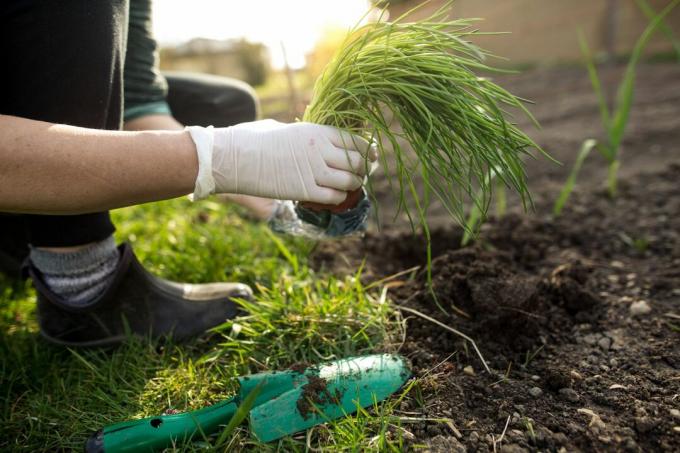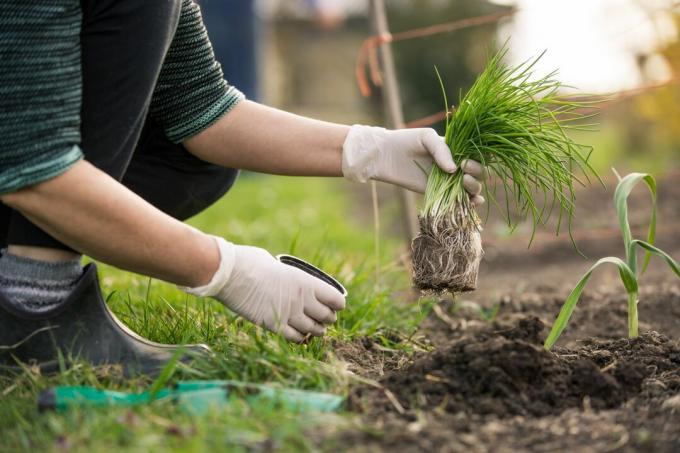Chives are one of the most popular kitchen herbs that are grown in the home garden. We will explain in detail which locations are suitable and how to plant chives correctly.

Fresh Chives (Allium schoenoprasum) is suitable for many dishes and is easy to cultivate in your own garden or in a pot. Chives, which belong to the Allioideae subfamily, are associated with both onions (Allium cepa) as well as with garlic (Allium sativum) and leek (Allium porrum) closely related. Due to its slightly spicy taste, it is very popular in the home kitchen. It is also known for its purple flower heads that beautify the garden. In our main article you will find a short profile, as well as care and harvesting tips for chives.
In this article we will also show you how you can sow chives in pots or beds at home and cultivate them for several years.
contents
- Planting chives: what is the right location?
- Plant chives in pots
- What is the right soil for chives?
- Sowing chives: How to proceed
- Prick out the chives and plant them out
Planting chives: what is the right location?
The cultivation of chives is basically quite simple and usually succeeds without any problems. A sunny to partially shaded, warm spot in the garden is ideal for chives. A slightly sandy, humus-rich and well-aerated, loose soil is ideal. Constant soil moisture is also important for the herbaceous plant so that it can grow healthily. Slightly acidic to neutral soil conditions are preferred by chives to calcareous sites. In addition, the plant can easily be grown in a raised bed or in a greenhouse.

tip: However, leaving the plant permanently indoors can lead to reduced growth, as the light intensity there is often insufficient. It is therefore better for the chives to move to a warm outdoor location during the sunny summer months.
Plant chives in pots
When cultivating chives, the following applies: the leek plant can be cultivated both in pots and outdoors. The choice depends on personal taste and the space available. If you want to plant chives in a pot, you should ensure that the potting soil is always loose and never saturated with water. Holes in the bottom of the pot are therefore extremely important. A layer of expanded clay should always be placed in the bottom of the pot so that the water can drain off easily. Chives from the supermarket are usually sold in pots that are much too small, which is why it is advisable to repot them quickly. However, it is also possible to sow chives directly into the pot without any problems - the procedure for this is described below. A bright, sunny place in the fresh air is suitable for the pot in summer. During the cold season from the beginning of October, the chives can move to a cool, frost-free place, but better not to the warm apartment. If you still want to harvest vital plants in winter, you can use the chive forcing process.
Tip: When forcing chives, the group of plants changes its place and is cultivated indoors. However, if the chives are simply placed in the autumn, reduced growth is observed and the plants can even die. You can find out how you can have healthy chives in your home even in winter with the help of forcing chives in our main article chives.

What is the right soil for chives?
Chives need a nutrient-rich soil. Many herb lovers instinctively reach for nutrient-poor herb soil for any type of herb. Such soil is perfect for aromatic plants that love low nutrient supply and lose flavor when too many nutrients are available. But it's different with chives: the leek plant has one high nutrient requirements and does not rely on dry, coarse soil, which herbal soil tries to mimic. On the other hand, a universal soil like ours is perfectly suitable Plantura organic universal soil based on compost. It supplies nutrients as needed over a long period of time by soil organisms releasing nutrients from the compost. In addition, our Plantura universal soil is made completely peat-free and without the addition of animal products, which protects the environment.
Sowing chives: How to proceed
If you want to grow chives yourself, you have several options. However, sowing seeds is certainly the most common method. The ideal time for this is between March and July. Chives is a cold germinator, which is why it needs a cold stimulus at the beginning of vegetation. Seeds harvested from your own plants should therefore be left for about two weeks before sowing the chives be chilled – this signals to the seed that a winter has happened and encourages it to germinate at. Refrigerator temperatures are completely sufficient for this. Then the seed is sown, a temperature of about 12 to 18 °C is optimal. Higher or lower temperatures may take longer to germinate, typically taking 7 to 14 days before seeds visibly germinate. Purchased seeds that have been stratified no longer need to be chilled in advance, but can be sown directly.
The seeds are placed at a depth of 1 to 2 cm directly in the bed or in a pot - ideally in a high-quality potting soil like ours Plantura organic herb and seed soil – seeded. You do not have to pay attention to an exact seed spacing, scattering the seeds loosely is the best method. Chive seeds only germinate in the dark and must therefore be covered with soil. The seeds should be pressed lightly, watered well and kept constantly moist for the next time. If the chives are sown in a pot, you can cover the pot with a pane of glass or cling film to create a greenhouse climate. However, the lid should occasionally be lifted briefly to prevent fungal infestation.
tip: You can get precise instructions and all the necessary tools for sowing chives in our Plantura Herb growing kit. You will also find four other aromatic kitchen herbs for the windowsill or the herb bed.
Prick out the chives and plant them out
If you want to prefer the seeds in a warm place, you can transplant the young plants outdoors as soon as they are about 5 cm tall. For this is the best time between April and July, when there are no longer periods of frost and the leaves can no longer freeze off. It is also important to transfer the young plants to larger pots with nutrient-rich soil after germination in seed soil. A high-quality potting soil like ours is again suitable for this Organic universal soil. The addition of a fertilizer in granular form can also promote growth in the long term, as the chives are constantly provided with all the important nutrients. Our Plantura organic universal fertilizer For example, provides the best conditions for healthy and vital growth through a balanced nutrient ratio.

Further measures such as pricking out or turning are not necessary with chives. How to properly care for the young chives and let them grow into a strong plant, we explain in detail in our article on Care of chives.
As part of a mixed culture Chives are particularly suitable because they have a positive effect on numerous diseases in other types of fruit or vegetables. For example, the risk of gray mold on strawberries (Fragaria) or the risk of infection of cucumbers (Cucumis sativus) with downy mildew lowered.
A mixed culture with deep-rooted vegetables such as salsify (Scorzonera hispanica) or radish (Raphanus) is just as possible as cultivation in the vicinity of tomatoes (Solanum lycopersicum) or other herbs like dill (Anethum graveolens), Parsley (Petroselinum crispum) or thyme (thymus).

Because of the poor self-compatibility of leek species, chives should not be grown directly with other Allium species. With new plantings, it is therefore advisable to ensure a break in cultivation of four to six years on the area. In cabbage plants (Brassica) like kale (Brassica oleracea var. sabellica), kohlrabi (Brassica oleracea var. gongylodes) or radishes (Raphanus sativus var. sativus) problems can also arise, which is why a mixed culture does not make sense. Various chive varieties also offer an opportunity to bring a little more variety into the local vegetable patch.
Have you got a taste for fresh garden herbs, but don't have a bed yet? We'll tell you how to make one Create and plant a herb spiral.

